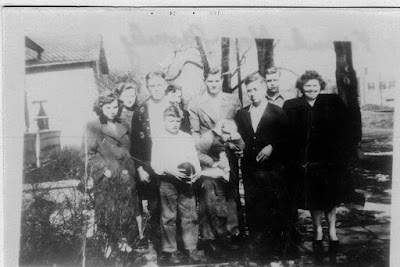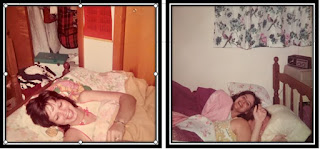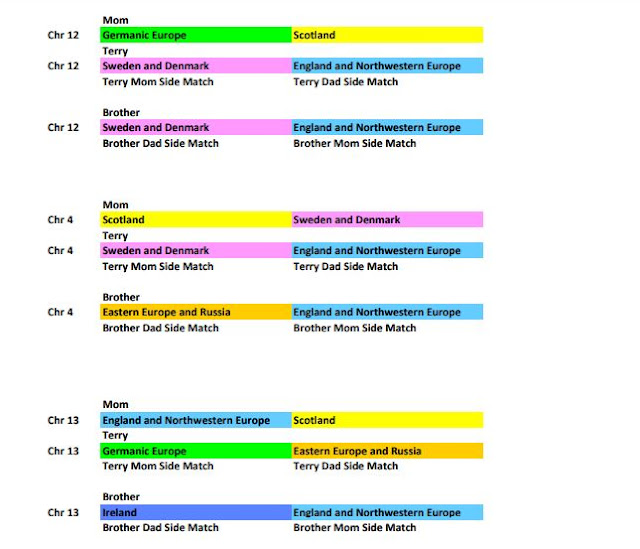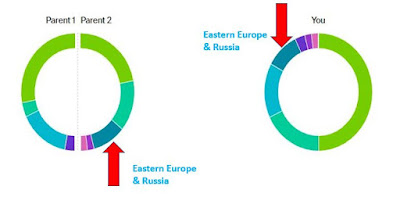The picture below was taken 8 days before Thanksgiving 1916. It is the wedding picture of my maternal grandparents, Frank Eugene Hoy and Katheryne Cecile Lynch. The date was November 22, 1916. I asked my grandmother once where she and grandpa met. She had a twinkle in her eye when she told me it was at a Halloween Party, he was very handsome, and that was all she would say.
My grandparents would go on to have nine children (who would give them 29 grandchildren), but the two of them were such opposites that their divorce seems inevitable, Grandpa was a quiet gentle man, and Katie was, well, Katie. My grandmother was a natural storyteller, who never let anything as inconvenient as facts get in the way of a good story. As a child she seemed bigger than life, with her arms and hands constantly in motion making whatever point she intended. Honestly, she was a little terrifying to a quiet little girl who listened intently to her tales.
The next picture was taken on Thanksgiving in 1948 or 1949. My mother remembers they were all angry with their youngest brother, Delbert, because he refused to have his picture taken.
The two younger boys in the front row are my Uncle Donnie and the defiant Uncle Delbert (with his hand up before his face.) In the back, from left to right are my mother, my Aunt Evelyn, Uncle Johnny, Aunt Flossie, Uncle Dale, Grandpa, Uncle Bob and Aunt Florence. Aunt Florence inherited the storytelling gene, only her stories were always funny, and self deprecating. My mother tells me that I remind her of her sister, Florence which I have always considered a huge compliment. (Unless, of course, she is referring to the fact that Aunt Florence and I both snort when we laugh.)
The next three pictures are from Thanksgiving 1951. It's easy to date because in the picture of the "Outlaws" - that is actually what they called themselves - you can see a very pregnant Aunt Marion, who would give birth to my cousin in January 1952.
The first picture is that of my mom and her siblings. The back row is Aunt Florence, Uncle Johnny, Aunt Flossie, Aunt Evelyn, and Uncle Dale. The front row is Uncle Bob, Uncle Donnie, Uncle Delbert (this time making faces) and my momma.
The next picture is of the "Outlaws." The ladies in front are my Aunt Marge and my Aunt Marion.
In the back is my Dad, Uncle Boo, Uncle Alvin and to be honest, I'm not sure who the person on the end is. While my dad was overseas when I was born, my mom and I lived with my Uncle Boo and Aunt Ev and my cousins, Arlene and Linda. My Uncle Boo was a contractor and he built the first house that my parents owned. .
I'm not going to attempt to name all the cousins, but I will tell you that another fifteen grandchildren had yet to be born. (Including, yours truly.) Grandma Hoy is in the back row, next to her eldest grandchild, my cousin Janet. My cousin Janet was a natural to babysit for me when I was little. Later, when she got married, she asked me to be one of her hostesses. I was nervous, but honored.
I will be honest with you. I was an okay looking kid when I was little, but from about the end of second grade until almost the end of ninth grade, I was, to put it honestly, a hot mess. My nose had grown too quickly for my face, My teeth had come in too large for my mouth and I would later add braces to complete the hideous look. It was so bad that I overheard my paternal grandmother saying to my mom, "Terry isn't as pretty as Marcia." My mother, so loyal, told her that both of her girls were pretty.
I was devastated, but I decided, Fine. If I couldn't be the pretty one, I would be the smart one. Which was kind of its own joke because my petite little sister had a photographic memory, and learned to read at the age of four. The school wanted her to skip a grade, but because she was such a tiny thing my parents were a hard no on that idea.
Nonetheless, I threw myself into studying and bolstered by the fact that my second toe was longer than my big toe, and being assured by my dad that this was a sign that I was indeed, very intelligent, I ended up in an advanced math class, was later tapped for National Honor Society, and wore golden honor cords for my high school graduation. So all in all, it worked out.
At the time of my cousin's wedding, my nose and my face were now on the same page, the braces had come off, I refused any more short, short hair cuts, and I was able to smile again. So that night I was on the way to feeling better about my looks, but what sealed the deal was my dad. He came over to where I was cutting the wedding cake, had me put the knife down, and asked me to dance. It was a polka. I'd never danced to one before, and I haven't danced to once since, but my dad made me feel so graceful and beautiful. That was really the night I transformed from the ugly duckling into, if not a swan, at least swan like.
So this Thanksgiving, I am thinking about my childhood. How my parents were always there for me, supporting me, encouraging me, loving me and I am thankful for that blessing.
Happy Thanksgiving, everyone. Enjoy the day.
© 24 Nov 2022, Desktop Genealogist Unplugged, Teresa L. Snyder



































